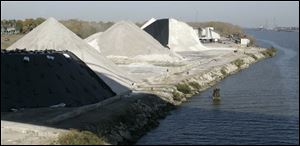
ODOT prepares for snowy season with dash for salt
11/2/2008
Building road salt stockpiles for Toledo and Lucas County was not cheap. Supplies, depleted by last winter's snow and ice-fighting efforts, remain tight and prices have almost tripled.
Dream all you like about a white Christmas. Many involved in wintertime road maintenance are praying for a brown one.
"I got real nervous the other day with all the lake-effect snow reports" from northeast Ohio, Dave Welch, Toledo's commissioner of streets, bridges, and harbor, said Friday. "It was concerning me that it was so much [snow], this early."
That's because road salt supplies, depleted by last winter's snow and ice-fighting efforts, remain tight and what salt can be bought is expensive.
Mr. Welch and Keith Earley, the Lucas County engineer, both said they had enough salt on hand or scheduled for imminent delivery to cover their consumption during a normal winter.
But building those stockpiles was not cheap, and Mr. Earley noted that some smaller buyers haven't found salt at any price this fall.
While the city got an initial 15,000-ton order in at $37.75 per ton, a more recent order it and Lucas County placed with Morton Salt cost $65.69 per ton, nearly triple the $22.73 that road salt cost them last year.
Combined with higher prices for the county's earlier delivery, Mr. Earley said, "that's about another million dollars we had to put aside" for salt.
While Toledo's salt budget comes from special street assessments, Mr. Welch said, "we had to get more money from [City] Council" out of that fund, and even then didn't get as much salt as officials wanted.
Theresa Pollick, a spokesman at ODOT's district office in Bowling Green, said it's no different for the state's highway maintenance forces: This year's state salt contracts average $62 per ton, up from $42 per ton a year ago, and salt for delivery in northwest Ohio cost ODOT $64 per ton.
Besides ordering as much salt under the old contract as would fit in its storage sheds, the transportation department also is taking ever-greater care with how it spreads the stuff, so that as much as possible it plays the intended role in keeping Ohio roads safe to drive during and after winter storms.
ODOT's "Smart Salt Strategy" focuses on using more precise spreading methods and spraying brine into trucks' salt spinners to moisten it so it sticks on contact with pavement, said Layth Istefan, the department's highway management administrator in Bowling Green.
And an increasing number of trucks in the local district are equipped with infrared temperature sensors, so drivers can tell if pavement is above or below 32 degrees.
"The driver can tell what's frozen and what's not," Mr. Istefan said.
So far, he said, 65 of 116 trucks are sensor-equipped, and 12 more will be outfitted soon.
ODOT has about 500,000 tons of salt in storage statewide, Ms. Pollick said. In a normal winter, it spreads about 700,000 tons, but last year it used more than 900,000.
In the eight counties covered by the Bowling Green district, ODOT's salt usage ballooned to 66,834 tons last winter from 33,648 the winter before, which was very mild.
The 58.1 inches of snow that fell last winter at Toledo Express Airport was the sixth highest on record and more than 20 inches above the 37.6-inch average recorded since 1971.
Mr. Welch said his forces spread about 50,000 tons of salt last year, 15,000 more than normal.
He and Mr. Earley said city and county crews will do their best to conserve supplies by spreading salt more carefully, prewetting it, and curtailing use during storms and at night when salt's effectiveness is reduced.
"We're not going to be as liberal with it as we have in the past," Mr. Welch said.
"Our spreaders are already calibrated, but we'll calibrate them more tightly. We probably will not continually salt through a storm, and we'll make greater use of brine, calcium chloride, and Ice Ban to stretch it out."
Ice Ban is a trade name for a magnesium chloride product that substitutes or augments salt.
ODOT also is continuing its experimental use of Geo-Melt, an ice-melting material made from beet juice.
Geo-Melt costs about four times as much as salt brine, Ms. Pollick said, but the state is testing its effectiveness in a 15 percent solution with brine on state highways in Lucas, Sandusky, and Seneca counties this year, plus Toledo-area freeways maintained from the Northwood outpost.
"Last year we didn't get an adequate measure of how effective it was because we had so many rain events," the spokesman said, referring to storms that started out rainy and thus washed away pretreatment brine and brine mixes before the precipitation changed to snow, sleet, or freezing rain.
Mr. Welch said he's particularly concerned about the upcoming season because forecasting services to which the city subscribes have predicted a winter similar to last year's.
But Mr. Earley, while believing in being prepared for whatever winter brings, was skeptical about such predictions.
"I don't put a lot of confidence in those long-range forecasts," he said. "We just have to wait and see."
Contact David Patch at:
dpatch@theblade.com
or 419-724-6094.